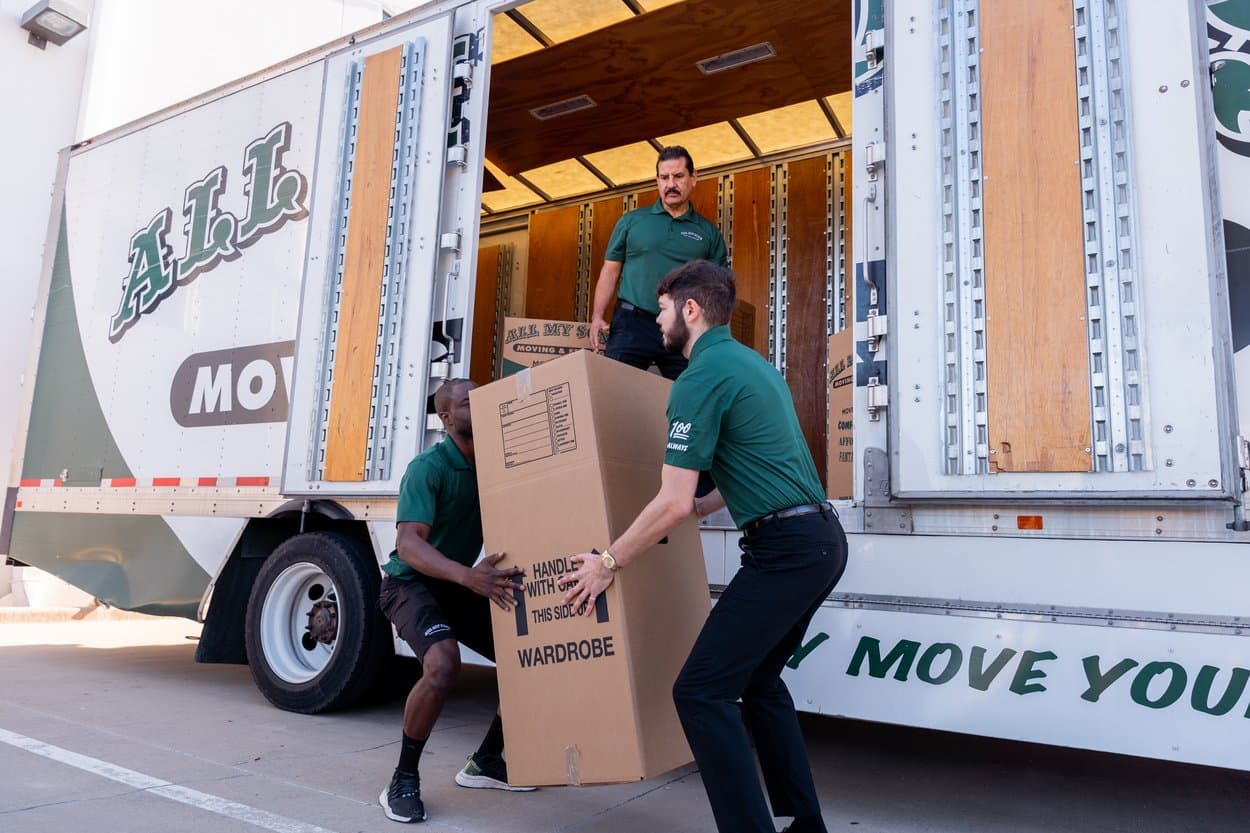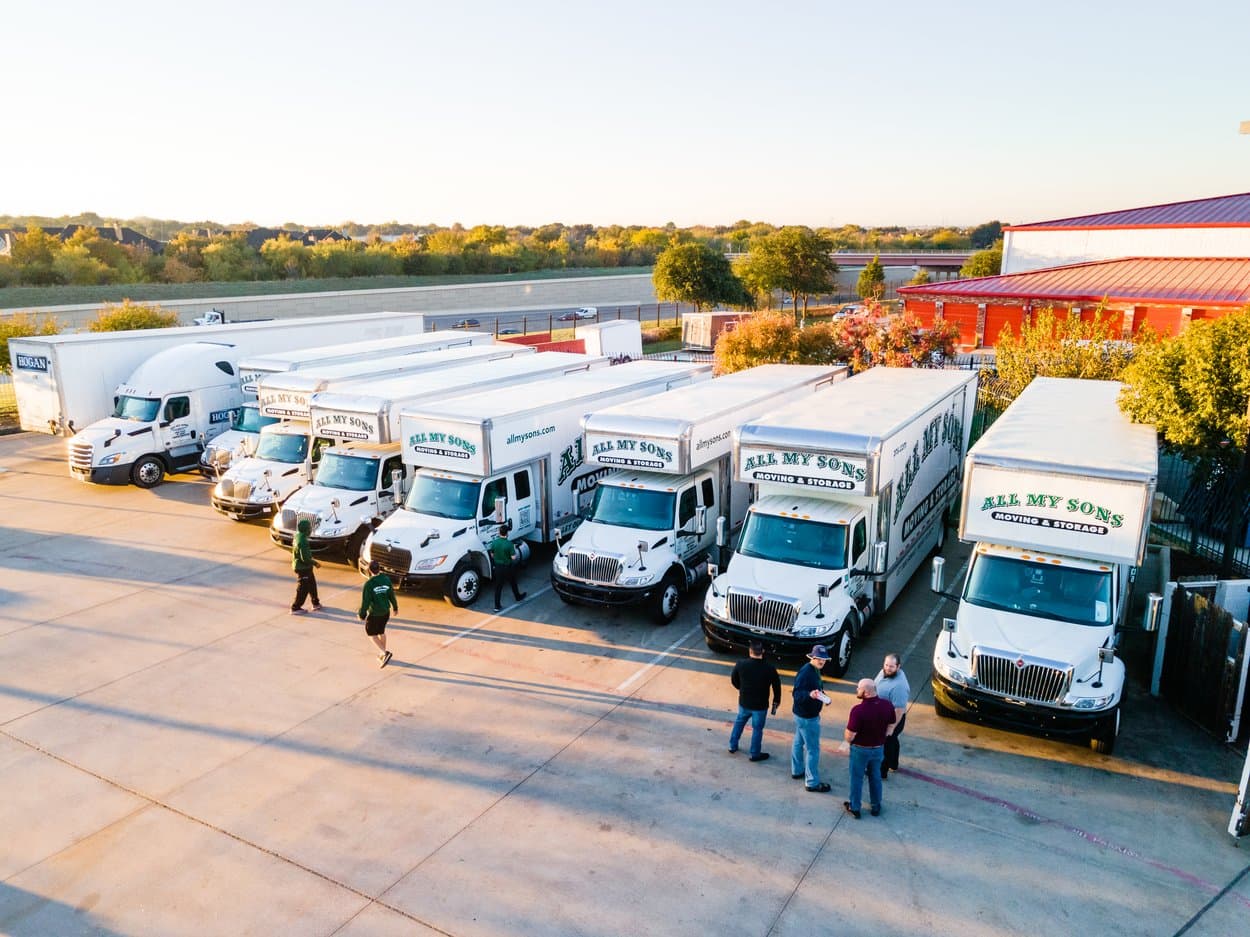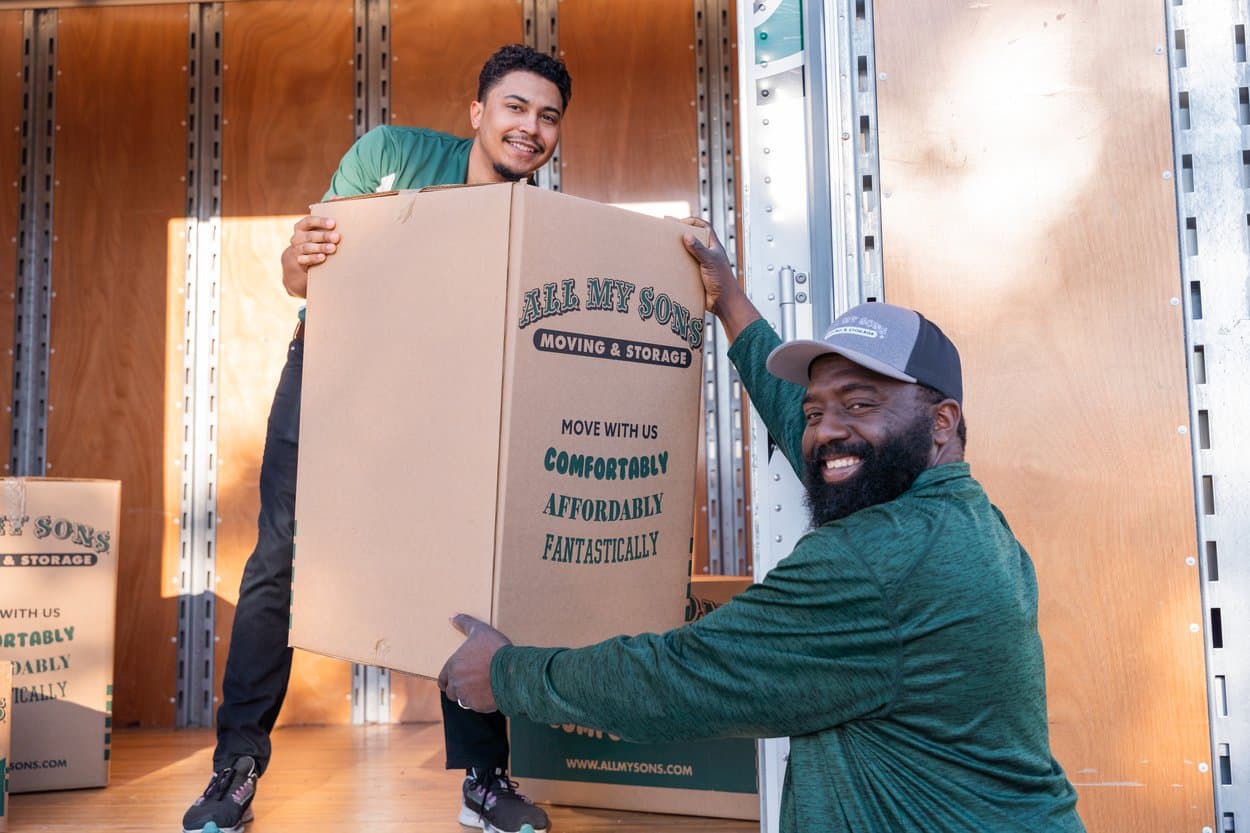Embarking on an Apartment Hunt?
The experts in apartment moving at All My Sons Moving & Storage weigh in on how to find an apartment in 2025.
An apartment can make a cozy, urban home for students, young professionals, and some budding families. According to the National Multifamily Housing Council (NMHC), about 45.6 million households in the United States are renters and of those renters 39% live in apartment buildings.
Our team at All My Sons Moving & Storage knows that moving into an apartment is a unique challenge. There’s limited parking, narrow stairwells, and tight doorways that make the logistics of moving more complicated, but All My Sons Moving & Storage is up for the job. We performed roughly 83,100 apartment moves in 2024, which was about 38% of our total moves for the year.
Before you can move in, you need to find the right place to call home. Whether you’re setting out to find your first solo place or you’re a seasoned renter, apartment-hunting can be its own special flavor of stress and anxiety.
Here are ten steps that can help you choose your ideal apartment.
Step 1: Determine Your Needs
First step, write out a list of your non-negotiables. If you are renting with roommates or family, then you will likely have to complete this step together.
Here are a few questions to consider that will help you determine what you absolutely must have in your next apartment:
How many bedrooms and bathrooms do you need? If you’re renting by yourself your needs here will be different than if you were renting with roommates or family members. A small studio apartment with one bathroom could work perfectly for a solo renter or a couple, but if you’re looking to get a place with your three best friends then you probably want more space.
Do you have pets? Fido is absolutely coming with you, and you need an apartment that is pet friendly. You’ll have to factor the cost of pet deposits and pet rent into your budget.
Need laundry in-unit or on-site? If you do not own a washer or dryer and you have vowed to never use a laundromat again, this will be on your list of needs.
What security measures do you consider absolute musts? Consider what you need to feel safe in your apartment. You might prefer a unit to come with its own alarm system or be behind a gate with controlled access.
What accessibility features do you require? If you or one of your roommates has difficulty traversing staircases, you might need an apartment with first-floor units available, or an elevator.
After you go through the first four steps of this guide, you may decide that a few other items like price and location also fall on your non-negotiables list.
Once you have written out the non-negotiables, you can weed out the listings that fall short without mercy.
Step 2: Determine Your Wants
After the list of musts comes the list of would-be-nice-to-haves.
What amenities do you want in your unit, at your complex, and in your community?
Some common apartment amenities include:
Fireplaces
Hardwood floors
Patios
Energy-Efficient Appliances
Balconies
Spacious closets
Swimming Pools
Fitness Centers
Dog Parks
Playgrounds
Storage Spaces
Designated covered parking
Online payment portals
Co-working spaces
Once you have considered the different amenities available to you, then you can pick and choose which ones will be most beneficial to you. Your apartment should feel like the home that best suits your lifestyle, whether that means you have a spacious play area for your beloved dog or plenty of closet space for your collection of formal dresses.
Step 3: Find the Ideal Location
Location, location! Where your new apartment lies will have a significant impact on your daily commute, how often you can see family and friends, and where you’ll be able to hang out.
Identify the places you most want to be nearby. These could be:
Workplaces for you or your spouse.
Colleges or schools for yourself or your children.
Homes of loved ones.
Community hubs you frequent like your church, your gym, the library, or a favorite coffee shop or bar.
Once you have identified a few key places you want nearby, create a 5 to 10 mile radius around those places. If you have an overlap between two key places, you’ll be able to narrow down your search to that area. If there is no overlap, you should decide which area you most desire to be close to. It could be for this next season of life you want to be closer to an aging parent than you do to your job.
Step 4: Set the Budget
Conventional wisdom says to aim to spend only a third of your income on rent. Many apartment complexes will verify that you make three times the rent before they approve your application. Rent will typically be the largest expense you have in your budget, so choose an apartment that’s within your means.
When you’re creating your budget, you should also consider a few other line items that will come with your move.
Upfront Costs: Application fees, deposits, and any prorated rent amounts that are due when you move in.
Moving Costs: Getting all your furniture, décor, and boxed-up stuff into your new apartment will take some heavy lifting. You could go the Do-It-Yourself route and beg family and friends to help, but you will likely still need to rent a moving truck or pick up moving supplies. Check out our guide on the hidden costs of moving to learn what you should budget for when you’re moving into an apartment.
Utilities: If certain utilities like heating, water, electricity, gas, internet, or cable are not included in the cost of your rent, you will need to calculate those bills into your living expenses separately. While you’re checking out an apartment, find out what utilities you will need to cover yourself and be sure to include the average cost to pay that utility in your budget.
Furniture: For first-time renters, the cost of furniture for your new apartment could be a significant investment. Even if you have furniture already that you are moving in, you may get to your new place and discover there are pieces you need like more bookshelves or a new couch. To save money, you can shop secondhand or use a buy-nothing group to get the necessities.
Carefully planning your budget for both your move and the rest of your year in your new apartment will help you meet your financial goals and enjoy life in your new community.
Step 5: Look at Listings
There are a lot of great places on the web to find apartments up for grabs. Many of these online listing sites will tell you almost everything you need to know about the apartment, from how much rent will be to what amenities are offered.
Here are some of the major sites offering apartment listings nationwide:
If you’re looking for a space in a certain city or state, you might have great luck on a local-specific site.
You don’t just have to search online. Remember your list of places you wanted to be nearby? Pick your top place and check the immediate area for apartment complexes. You can also find listings available on community bulletin boards in coffee shops or on your college campus. Sometimes you can find a great home right in the backyard of one of your current favorite hangouts.
Step 6: Prepare Questions
Now that you’re narrowing your search down to listings that meet your needs and wants, it’s time to make your short list for apartments to visit in person. Once you have a couple apartments you’d like to visit in person, you should create a list of questions to ask the leasing agent when you’re there.
Some of these questions will be answered in the lease agreement or found online and some of them you may prefer to get the leasing agent to answer in person.
Here are some sample questions you should probably ask or find the answer for:
What deposits or move-in fees are due upfront? Some apartment complexes have additional fees they want paid before you move in.
Will the complex require renter’s insurance? It might not be legally required in your state, but some apartment complexes require you to have renter’s insurance before you can move in.
How can you break your lease if you suddenly need to move out? Life happens and there could be any number of reasons you need to relocate before your lease is up. In the event of a sudden job change or a family emergency, you need to know if it’s possible to get out of your lease and if you must pay any penalties to do so.
How much notice do you need to give before you move out? Most apartment complexes will require at least 30 days notice in writing before a move-out, but some complexes will require more.
What happens when you need to pay rent late? Of course you don’t want to have to pay rent late, but any number of things could happen in the future like a job loss or a medical emergency. It’s better to know what your options are ahead of time.
How much notice is required before the landlord can enter the apartment? In some states landlords are required to give notice before entry for inspections or routine maintenance. If there is an emergency, the landlord might not have to provide the same notice. These conditions will usually be spelled out on your lease.
What decorating changes can you make to the apartment? Before you go painting cabinets or hammering nails into your walls, you should be aware of what changes to the apartment are allowed by your lease.
What’s the policy on subleasing? If you need to move out, you should ask if you would be able to have someone else to take over your lease. Some properties will not allow this.
What’s the policy on visitors in the apartment? If you have guests, especially guests who stay overnight, you should ask if the property has rules about visitors or how many nights someone can stay before they must be added to the lease.
Where will visitors be able to park? Some apartment complexes will have designated parking for their residents and any guests who park in those spaces will be towed. To save your future visitors some headache, ask where your visitors will be able to park when they’re at your place.
How responsive is maintenance? When you have maintenance needs, it’s important to know soon they will be taken care of. Ask if there’s a maintenance team on site or if there’s a team on call in case of emergencies.
How long does it take for an application to be approved? When you’re feeling confident you love an apartment, you should ask about the timeline for getting approval and any other questions about the approval process that you might have.
Questions in hand, it’s time to start driving to your prospective apartments.
Step 7: Visit in Person
Once you have narrowed down your list to the apartments that meet all your needs and fulfill a good deal of your wants, you should visit places in person and see what the units actually look like.
The leasing agent might show you a vacant apartment, a model apartment, or a similar apartment. Walk around and get a good feel for the place, ask your questions of the leasing agent, and try to picture your next chapter in this apartment.
When you visit an apartment, also check out the neighborhood. Where’s your closest grocery store, hospital, fire station, and police station? What restaurants nearby look interesting or what stores do you think you might happily frequent? The quality of your neighborhood will have an impact on your overall happiness as well, so don’t forget to look around before or after you look at the apartment itself.
Keep in mind that apartments in high demand will be off the market again fast. You might have to make a decision about these apartments almost immediately after you view them. If you’re looking at an apartment with a long list of applicants waiting, it may be in your best interest to be prepared to pay a deposit on the day you visit in person. This puts you ahead of the pack.
Step 8: Read the Lease Agreement
You can ask for a copy of the lease before you make your application so that you can read through it carefully. Look for the answers to your previous questions in writing, even if the leasing agent gave a satisfactory answer. A lease is legally binding, and you want to know exactly what you’re signing on for before you make the jump.
Step 9: Make Your Application
The average apartment application fee is $51. This amount will vary based on your location and the demand for the apartment.
You will need to provide:
Photo ID: A driver’s license or passport should work for U.S. Citizens. If you are a resident rather than a U.S. Citizen, you will probably need your green card or visa as proof of identity.
Contact Information: Your phone number, email address, and a current address at which you can be reached. If you do not have a current address then you might be able to provide the address of a family member that can reach you.
Proof of Income: This could be your past few months of pay stubs, an offer letter for a job, or bank statements showing you make enough income to cover the cost of the apartment.
Your Social Security Number: Your prospective landlord will want to run a background check and credit check on you. If you do not have a social security number then you will need to provide your student visa or green card.
References: Some landlords will want to talk to someone who can verify that you are reliable like a past landlord or a personal reference.
Rental History: You may be required to write out the last five to ten years of your rental history, including the addresses of your previous rentals and the dates that you occupied those rentals.
Co-signer or Guarantor: If you are a first-time renter, make less than the required income, or have poor credit then you might need someone else who does meet the requirements to sign with you. This person will likely have to provide their own proof of income and rental history.
Once you have submitted all this information, you wait for a call or an email from the apartment complex. Hopefully you asked the leasing agent about how long it takes for an application to get approved when you toured the apartment. This process can be completed in as little as 24 hours or as long as one week. If it has been more than a week since you submitted your application and you have not heard back yet, it’s okay to reach out and ask for an estimated timeframe.
Step 10: Prepare to Move In
Once your application has been accepted, congratulations! Now your new apartment home should be able to provide you with a pre-move-in checklist for you to accomplish before you can grab your keys and move in.
This pre-move list will include:
Deposits and First Month’s Rent: Your complex may offer an online payment portal for you to submit your payment or have you turn in a check at the leasing office.
Proof of Renter’s Insurance: If your property requires renter’s insurance, then they will ask to see proof that you have an active policy before you move in.
Putting the Utilities in Your Name: Your apartment complex may provide you with a list of utility companies they work with, or you will have to find a company that services your area. Call the company and provide your new home’s information so that you can get your electricity or heating connected before you move in.
Proof of Pet Vaccinations: If you are moving in with pets then you may be asked for proof that your pets are up to date on their shots. Your veterinarian can provide a sufficient document for proof of vaccinations.
Once all the paperwork is in order and your lease is signed, you should be able to pick up your keys at the front desk. Prepare to make this apartment your new home.
Get Settled into Your New Apartment Home
When you’re ready to move into your new apartment, call the specialists in apartment moving at All My Sons Moving & Storage. We understand the challenging logistics of helping renters get settled, whether you’re moving into a ground-floor duplex or a high-rise apartment.
Give our nationwide line a call at 1-866-726-1579 to reach one of our 90+ locations across the United States, or get started with an online quote to get ready for your big move to your new apartment.
Quick Moving Tips

How to Pack Clothes for a Move
All My Sons Moving & Storage provides professional packing services and has some special tips for packing your clothing for moving.

How to Make a Seamless Business Move
Tips for pulling off your business move from the experts in commercial moving services at All My Sons Moving & Storage.

How to Pack a Computer for a Move
Here are 5 steps that should help you get your computer secured for the move.


